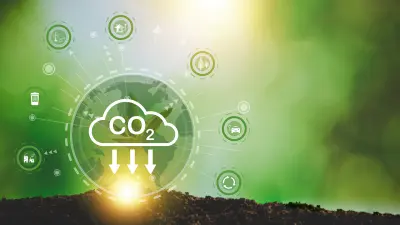Innovative solutions for capturing CO₂ from the atmosphere
In view of the current challenges, simply avoiding CO₂ is no longer sufficient. For this reason, Bosch Research is devoting intensive research to actively removing CO₂ from the atmosphere.

Climate change poses one of the greatest challenges of our time. Numerous studies show that the goal of the 2015 Paris Agreement¹ to limit global warming to below two degrees Celsius by 2050 compared to the pre-industrial era will no longer be achievable by simply reducing and avoiding CO₂ emissions. What humanity needs in addition are so-called negative CO₂ emissions, i.e., the removal of CO₂ from the atmosphere — regardless of when and where it was emitted. Currently, around 40 gigatons of CO₂ are emitted worldwide every year. The Intergovernmental Panel on Climate Change (IPCC) calls for CO₂ neutrality by around 2050. Decarbonizing the energy supply and mobility, as well as CO₂ avoidance through savings and efficiency improvements, especially in industrial processes, are the most important vehicles to achieve this. Nonetheless, around a quarter of current global CO₂ emissions, or about 10 gigatons, remain as residual emissions. To compensate for these emissions, CO₂ must be removed directly from the atmosphere and be permanently stored.
The need for action is a political consensus: With the European Green Deal, for example, the 27 EU member states have formed a legally binding agreement to become climate-neutral by 2050. The interim target is a reduction in greenhouse gas emissions of at least 55 percent by 2030 compared with 1990 levels. For this reason, experts at Bosch Research are working intensively on solutions to avoid CO₂ emissions or, if they cannot be avoided, to capture CO₂ from the air. After this capture, the CO₂ must be transported away and ultimately used or permanently stored. Currently, Bosch Research is focusing on the evaluation of various separation technologies that fit well with Bosch's competencies and core business.
CO₂ capture: One goal — various solutions

There are different approaches to removing CO₂ from the atmosphere (Carbon Dioxide Removal, CDR). Nature-based solutions (NBS) are measures that focus on the protection, restoration and sustainable management of ecosystems. This includes, for example, the reforestation of forests, which naturally remove CO₂ from the air, as well as the renaturation of peatlands, which bind large amounts of carbon.
One of the technical solutions is the Direct Air Capture (DAC) method, in which CO₂ is extracted directly from the air. Other technologies capture CO₂ directly where it is emitted, such as in coal- or gas-fired power plants. Bosch Research currently sees many advantages to DAC technology, including scalability and site flexibility.
“Vacuuming” for the atmosphere: Permanently removing CO₂ from the air
Bosch Research is therefore conducting research on technologies that help to capture CO₂ from the ambient air. At present, Bosch Research experts are primarily researching the LT-DAC method (LT stands for low-temperature). Put simply, it works like a giant vacuum cleaner that takes in large amounts of air from the environment. A lot of volume is necessary, because the CO₂ content of the ambient air is currently about 0.04 percent. The air is processed in three steps: A fan draws the air into the interior of the collector, where it passes through a chamber containing a CO₂-absorbing material to which the CO₂ molecules attach. When the material is saturated with CO₂, the chamber closes. It is then heated to about 100 degrees Celsius. In the process, the concentrated carbon dioxide is released again. Now it can be separated and reused or stored permanently.

In addition to suitable technological solutions, Bosch Research is evaluating market entry scenarios and potential partners for CO₂ capture. Because while the price of CO₂ will rise steadily in the coming years, the cost of DAC plants will continue to fall. Research into the use of CO₂ as a raw material for industrial applications is also in full swing.
CO₂ in figures²
66 %
Among the greenhouse gases, CO₂ is the largest contributor to global warming, accounting for around 66 percent of the total. It is followed by methane (CH₄) with about 16 percent and nitrous oxide(N₂O) with about 7 percent.
45 %
Since the beginning of industrialization, the concentration of CO₂ in the atmosphere has increased by 45 percent.
+ 1.2 °C
The global temperature increase in 2020 was about 1.2 °C compared to the period 1800 to 1900.
< 2 °C
According to the Paris Agreement of 2015, global warming is to be limited to well below 2 °C and, if possible, below 1.5 °C.
4.6 %
Germany’s cumulative share of global greenhouse gas emissions since 1850 amounts to about 4.6 percent.
¹ source: IPCC AR6 Synthesis Report: Climate Change 2023
² source: IPCC AR6 Synthesis Report: Climate Change 2023